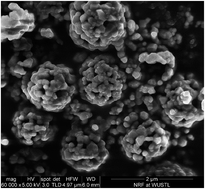Trace level doping of lithium-rich cathode materials†
Abstract
Lithium ion batteries have revolutionized portable electronics and have the potential to electrify the transportation sector. Lithium-rich cathode materials with the composition xLi2MnO3·(1−x)Li(Ni1/3Mn1/3Co1/3)O2 have received considerable attention as candidates for Plug-in Hybrid Electric Vehicles (PHEVs) and Electric Vehicles (EVs). Cathodes made from these materials display high capacity (>200 mAhg−1) and good cycling stability, offering twice the energy density of currently available intercalation materials. Unfortunately, their performance is plagued by voltage fade due to a layered-spinel phase transformation. Herein, using spray pyrolysis, we show that certain inexpensive trace level (≤1%) dopants can help in mitigating voltage fade, when the material is cycled between 2.0–4.6 V. The dopants lead to greater capacity loss than what would be expected from a capacity that is strictly based on a change in the transitional-metal oxidation state. The results imply that a portion of the capacity of these materials comes from reversible oxygen chemistry. These findings could put a different perspective on fade mechanism prevention.


 Please wait while we load your content...
Please wait while we load your content...